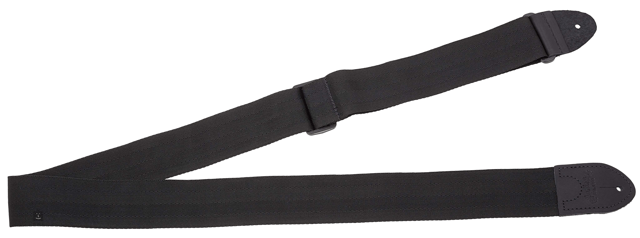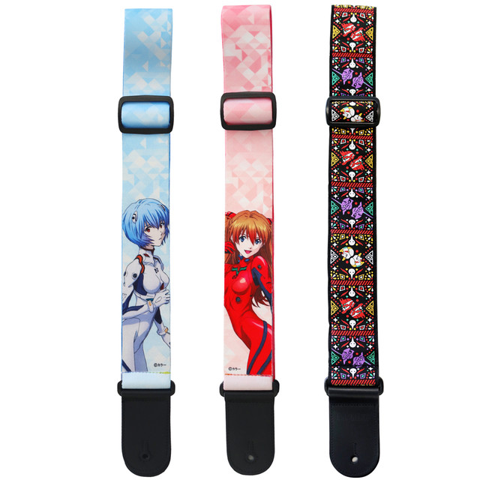Straps
I cannot possibly overstate the difference a good strap makes.
Electric guitars and basses are heavy instruments! It’s not uncommon for e.g. Les Pauls to weigh 5 kg (11 pounds) or more. That might not sound like much at first, but it’s a lot of weight to hang from your shoulder for hours at a time.
 A generic nylon guitar strap.
A generic nylon guitar strap.
A lot of players…
Including young Fox! Everyone makes mistakes.
…will just have grabbed the cheapest generic nylon strap in the shop when buying their first guitar — or maybe the store even threw in the strap for free! — without realizing how important strap choice is for player comfort and safety.
Fortunately, quality straps are not that expensive, and there is an entire world of much more ergonomic and comfortable solutions available. Let’s quickly explore the options available to us.
Choosing a strap
There are five aspects that matter in a strap: the material, the width, padding, adjustment method, and looks.
Material
Almost all straps are made out of plastic, cotton, leather, or neoprene.
Plastic (nylon, polyester, polypropylene) guitar straps are the cheapest and least pleasant to use, but they are extremely durable — they’re basically car seatbelts for your guitar, and they offer about the same level of comfort. Cotton straps are usually not much different in design, but softer.
Leather is what you’ll find most higher-end guitar straps are made of. There are a variety of leather strap designs out there, ranging from a simple strip of leather all the way to massive, multi-layer, generously cushioned and padded behemoths that feel not unlike a soft luxury car seat. You will also find leather straps made of all kinds of leather, including soft suede or vegan pleather.
Neoprene is a bit of a newcomer to the world of guitar strap materials, but it is quickly taking the market by storm. Neoprene is a type of synthetic rubber, resembling a dense, elastic foam. If you’ve ever been surfing, diving, canoeing, etc. — it’s what wetsuits are usually made of! Neoprene is soft and comfortable, vegan-friendly, and very durable.
Width
It’s pretty obvious that the wider a strap is, the larger the surface area in contact with your shoulder will be — and with a larger area to distribute the weight of your guitar over, the less pressure there will be on your shoulders.
The “standard” cheap nylon straps are generally about 2“ wide, but I’ve seen straps as wide as 4.5“. A 4“ strap (my usual for basses) will cut the pressure on your shoulder down to about half of what it would be with a 2“ strap, and indeed in my experience, when coupled with generous padding, a strap that wide makes the weight of the instrument almost disappear.
Padding
Going back to what I was saying about nylon straps and seatbelts — a seatbelt isn’t very comfortable, right? A padded strap is like adding a row of pillows to the inside of that seatbelt. Padding in itself will not reduce the amount of pressure on your shoulder, but it will make your strap much more comfortable to use and prevent it from painfully digging into your shoulder and back.
Adjustment method
There are generally two kinds of strap adjustment methods: stepped and continuous ones.
“Stepped” adjustment is most common in leather straps — I use the term to describe any adjustment method that lets you choose between a number of preset strap lengths. It does the job, usually, but I will often find that a guitar sits slightly too low in one position and slightly too high in the next.
“Continuous” adjustment straps do not have preset lengths — instead they let you adjust their length smoothly by moving one end of a loop of material. This is most common in nylon straps, but there are both neoprene and leather straps with continuous adjustment out there.
Looks
Straps don’t have to be just plain black or brown. If you want to look extra classy, maybe a completely white strap would provide the visual impact you need? A strap with a dense geometric pattern would complement a plain guitar wonderfully; perhaps you want to send a message by wearing one with the colors of your favorite pride flag, or characters from your favorite anime? Maybe you want one that’s entirely covered in spikes to look extra punk?
 Some patterned guitar straps.
Some patterned guitar straps.
You can find all kinds of patterns, colors, and graphics on guitar straps, and even places that will happily make you a custom strap. As usual: Etsy, Ebay, and Amazon have an entire world of options, and searching the Internet for “custom guitar strap” should provide you anything that you can’t find readily available from a store.
Thoughts
With strap choices, there aren’t really many tradeoffs — continuous adjustment is strictly better than stepped adjustment, a padded strap is pretty much always preferable to a non-padded one; the only real drawback is that the nicer straps will be more expensive, but straps are pretty cheap in general and your health and comfort is well worth the investment in a good strap.
Get yourself a strap that looks sick and feels great to wear. You’ll be glad you did.
Fox’s Gear: Straps
I have two straps that I use on all of my guitars:
All my heavy basses get a Minotaur 4“ Wide Padded Bass Strap: an absolute monster of a strap with padding so thick you could comfortably sleep on it, made of very tough Italian leather, while still costing less than $40.
I would happily make a blanket recommendation for these straps for heavier instruments (they’re a bit too stiff to use on anything lighter than 3.7 kg/8lbs-ish), if not for the fact that they seem impossible to purchase outside of Europe.
All my lighter instruments get Fender “Broken-In Leather” straps; these are not padded, but they’re made of extremely soft and pliable leather, which makes them very comfortable to wear despite the lack of padding and somewhat narrow (2.5“) width.
These are what I use, but I don’t think they’re the best options out there; both of these only have stepped adjustment, and the Fender straps are pretty overpriced for what they are; I just stick with the stuff I know I can depend on, without seeking out alternatives that may be better. For that reason — and because I don’t want to shill too hard, I don’t get paid a cent for writing any of this — I would suggest that it’s fine to use these as a starting point in your search for The Perfect Strap, but you should — as usual — Do Your Own Research.
If I didn’t already have a bunch of these and was shopping for a new strap, I’d definitely look towards neoprene rather than leather. Maybe some funky patterned straps, but I tend to lean towards the classy look of plain brown leather matched with natural and transparent finishes, and black leather to go with everything else.